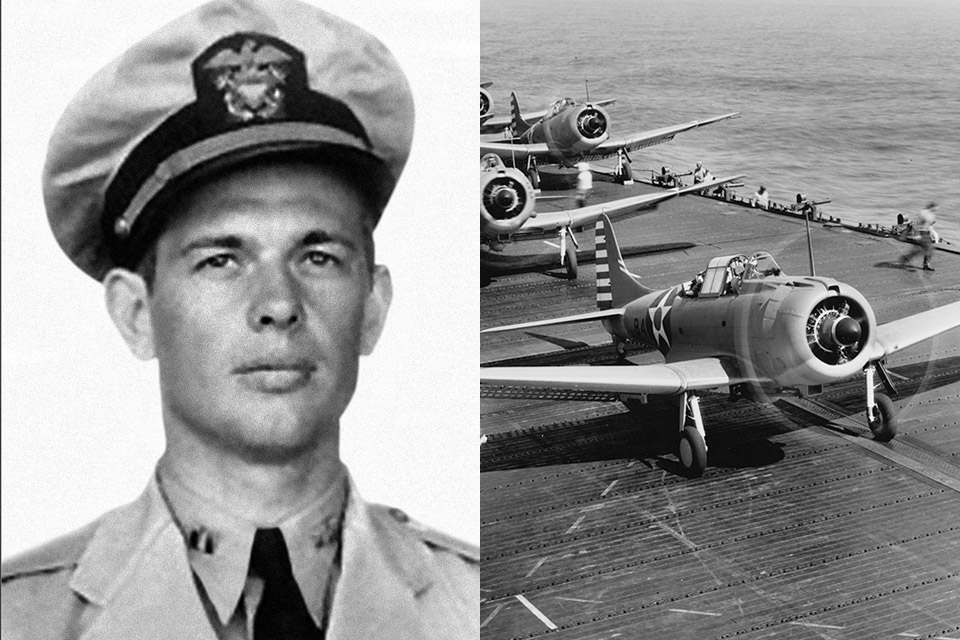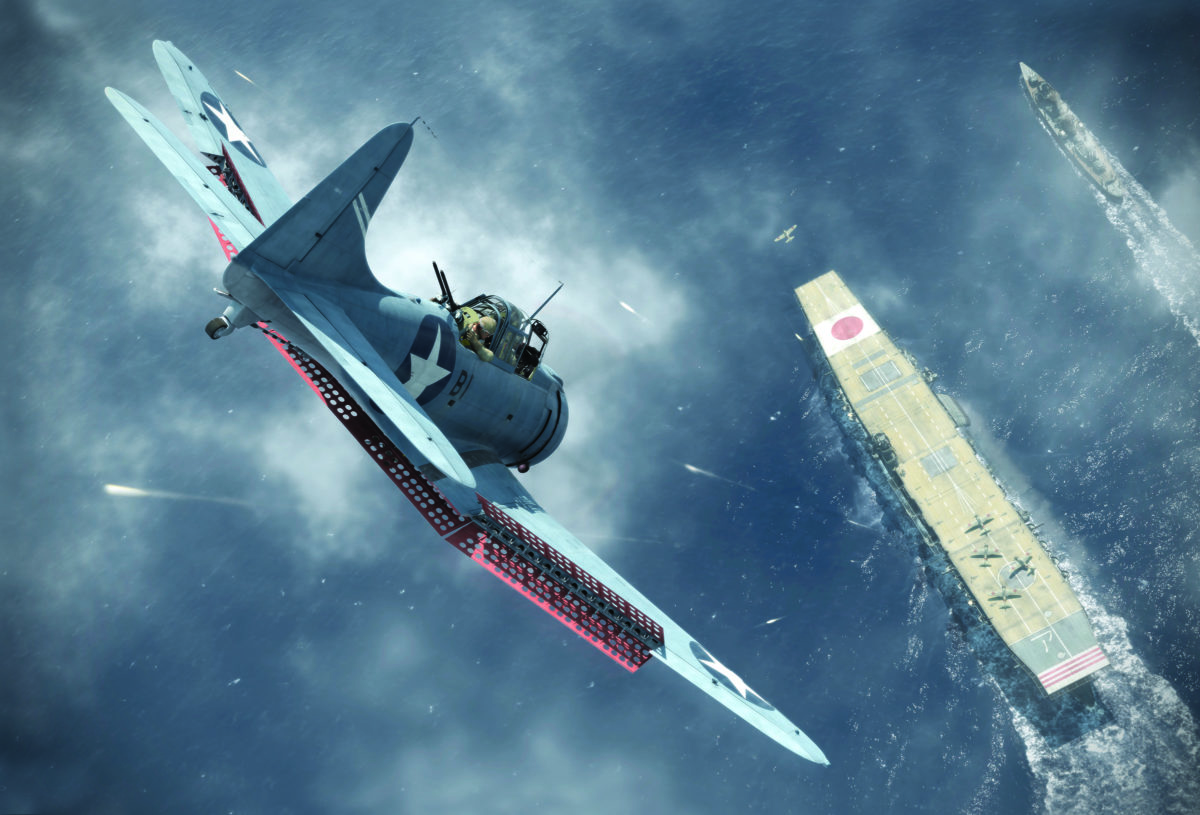In the age of industrial warfare, individual combatants seldom make a difference in a battle’s outcome. Richard H. Best was an exception. But he spent a decade en route to his rendezvous with destiny at the Battle of Midway.
Appointed to the U.S. Naval Academy from his native New Jersey, Best graduated in the class of 1932. Enamored of aviation, Ensign Best served the obligatory two years at sea before beginning flight training in Pensacola, Fla. An excellent student, he pinned on his golden wings in December 1935.
Best’s Pensacola grades earned him the most prestigious seat possible: Fighting Squadron 2, the “Flying Chiefs.” Staffed largely with noncommissioned pilots, VF-2 was widely regarded as the most professional unit in naval aviation. For the next two years Best flew Grumman F3F biplanes from USS Lexington.
After 2½ years aboard “Lex,” Best was offered patrol planes or instructing at Pensacola. He chose the latter, and used the time well. As he recalled, “The best way to learn a subject is to teach it, and that’s what I tried to do.”
In the spring of 1940 Best was ready to return to the fleet, and he surprised colleagues by requesting dive bombers. As an astute professional, he recognized that naval fighters were inherently defensive while bombers were offensive. “I knew that we would become involved in the war,” he said, “and I thought I could make the best contribution by flying bombers.”

Assigned to the carrier Enterprise, Best joined Bombing Squadron 6 (VB-6) in June. He became flight operations officer—third in seniority—and cultivated his considerable dive-bombing skills. As he candidly admitted, “I intended to become the best bomber in the Pacific Fleet.” Certainly he had ample opportunity: In late 1941 he logged as many as 90 hours per month.
On the morning of December 7, Enterprise’s Douglas SBD Dauntlesses were caught in the Japanese attack on Pearl Harbor. Several of Best’s shipmates were killed, leaving him with an abiding thirst for vengeance. He recalled seeing the Big E’s “number one” battle flag hoisted, “My most memorable sight of the war.”
As VB-6 executive officer, Best flew in each of Enterprise’s subsequent operations: hit-and-run strikes on Kwajalein Atoll, Wake Island and Marcus Island in February and March 1942. At Kwajalein he was jumped by Japanese fighters, which put holes in his SBD’s tail. His evasive maneuvers were effective: “Not enough deflection,” he observed with Olympian detachment. When flying with VF-2 he had towed the banner target for gunnery practice, “and I knew what a good run looked like.”
In May the Enterprise task force sped south during the world’s first carrier engagement, the Battle of the Coral Sea, but the Big E was too late to participate. Lexington was sunk and Yorktown damaged in exchange for a Japanese flattop, so the U.S. carriers were recalled to Pearl. In a frantic three days “Yorky” was fit enough to deploy in response to a dire threat—Japan’s effort to seize Midway Atoll, barely 1,100 miles from Honolulu.
The battle shaped up as a mismatch: Enterprise and Hornet operating together plus Yorktown in its own task force versus four veteran Japanese carriers. However, U.S. aircraft based on Midway evened the odds.
On the eve of Midway Best was a thorough professional with 2,700 flight hours and more than 300 carrier landings. Newly promoted to command VB-6, he was confident of his squadron and himself. Of the night of June 3, he said, “I slept like a baby.”
On the third call to man aircraft Best told his radioman-gunner, Chief James Murray, “Well, this is it!”
Enterprise lofted a full deckload: 34 SBDs, 14 Douglas TBD torpedo planes and 10 Grumman F4F fighters. But it took time, and at length the air group commander, Wade McClusky, headed outbound with his two Dauntless squadrons. Finding no Japanese at the briefed intercept point, McClusky began a box search and struck gold. Following the path of an enemy destroyer, he arrived over Admiral Chuichi Nagumo’s four carriers. Midway-based planes and the task force’s three torpedo squadrons drew the attention of the Zeros, leaving the SBDs a clear shot.
Historians still argue whether McClusky ordered a proper attack, but 30 Dauntlesses followed him down on the nearest carrier, Kaga. Best, narrowly avoiding collisions with the plunging SBDs, regrouped his two wingmen and went for the next target, Nagumo’s flagship Akagi. Attacking broad on the port beam, Best put his half-ton bomb into its hangar deck, igniting fuel and ordnance. His wingmen scored very near misses, and Akagi was doomed. So was Kaga.
And, incredibly, so was Soryu, victim of Yorktown’s just-arrived strike.
But the battle remained in the balance. When the remaining enemy carrier, Hiryu, was located, Best led his VB-6 survivors with overflow from the newly damaged Yorktown. That afternoon he made his second dive of the day, scoring his second hit. All four Japanese carriers were destroyed, and the battle ended with Yorktown’s loss on the 7th.
It was also the end of Dick Best’s career. That night he began coughing blood, the result of caustic soda in his oxygen rebreather system that activated latent tuberculosis.
Medically retired in 1944, Best spent the next several years recovering, then entered civilian life. He was an analyst for the RAND corporation until retiring in 1975. He died in 2001 but always said, “Midway was revenge, sweet revenge for Pearl Harbor.”
At the end of the 2019 film Midway, a what-happened-to-them montage notes that Best was one of two pilots to score hits on multiple ships in the battle. The other was his shipmate, Lt. (j.g.) Jack “Dusty” Kleiss, who hit Kaga and Hiryu on June 4 and the cruiser Mikuma two days later. Although Best is portrayed as a hotdog in the movie, attempting an impossible feat (an intentional deadstick carrier landing with no flaps from a steep dive directly overhead), British actor Ed Skrein captures his intense focus on winning his part of the war.
This article appeared in the January 2021 issue of Aviation History. To subscribe, click here!





